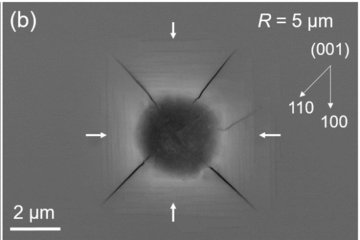All genres
461.
Talk
Ein nicht lokales Versetzungsdichte basiertes konstitutives Gesetz für Kristall-Plastizitäts-Finite-Elemente-Simulationen. Institutsseminar, Fraunhofer-Institut für Werkstoffmechanik IWM, Freiburg (2005)
462.
Talk
Die Kristall-Plastizitäts-Finite-Elemente-Methode und ihre Anwendung auf Bikristall-Scherversuche. Institutsseminar, Institut für Werkstoffwissenschaften, Universität, Erlangen-Nürnberg (2005)
463.
Talk
A texture evolution study using the Texture Component Crystal Plasticity FEM. Plasticity 2005, Kauai, USA (2005)
464.
Talk
A dislocation density based constitutive model for crystal plasticity FEM. Plasticity 2005, Kauai, USA (2005)
465.
Talk
How do 10^10 crystals co-deform. "Weitab vom Hooksechen Gesetz -- Moderne Ansätze und Ingenieurpraxis großer inelastischer deformation metallischer Werkstoffe'' Symposium der Akademie der Wissenschaften und der Literatur, Mainz, Germany (2004)
466.
Talk
Physically-Based Large-Scale Texture and Anisotropy Simulation for Automotive Sheet Forming. TMS Fall meeting, New Orleans, LA, USA (2004)
467.
Talk
Das Anwendungspotential der Kristallplastizitäts-Finite-Elemente-Methode aus Sicht der werkstoffphysikalischen Grundlagen. Werkstoffwoche 2004, München, Germany (2004)
468.
Talk
The Texture Component Crystal Plasticity Finite Element Method. Keynote lecture at the Third GAMM (Society for Mathematics and Mechanics) Seminar on Microstructures, Stuttgart, Germany (2004)
469.
Talk
Numerische Simulation der Metallumformung und Rekristallisation. Workshop, Simulation und numerische Modellierung, Materials Valley e.V., Mainz (2003)
470.
Talk
Simulation of Texture and Anisotropy during Metal Forming with Respect to Scaling Aspects. 1st Colloquium Process Scaling, Bremen, Germany (2003)
471.
Talk
Investigation of Nano Indentation Pile-Up Patterns in Copper Single Crystals. Euromat 2003, Lausanne, Schweiz (2003)
472.
Talk
Crystal plasticity FEM from grain scale plasticity to anisotropic sheet forming behaviour. 13th international Workshop on Computational Modelling of the Mechanical Behaviour of Materials, Magdeburg, Germany (2003)
473.
Talk
Microstructure mechanics: Investigation on deformation behaviour of grain boundaries. Plasticity 2003 (Keynote lecture), Québec, Canada (2003)
474.
Talk
Application of the Texture Component Crystal Plasticity FEM to Forming Simulation. Thermec 03, Madrid, Spanien (2003)
475.
Talk
Moderne Simulationskonzepte für den Werkstoff Stahl und seine Anwendungen. VDEh Werkstoffausschuss, Düsseldorf (2002)
476.
Talk
A Texture Component Crystal Plasticity Finite Element Method for Scalable Large Strain Anisotropy Simulations. ICOTOM 13, Seoul, South Korea (2002)
477.
Talk
Theory of Orientation Gradients. ICOTOM 13, Seoul, South Korea (2002)
478.
Talk
Texture-Components in Plasticity Simulations. ICAA8, Cambridge, UK (2002)
479.
Poster
Chemo-Mechanics-Damage coupling in DAMASK. M2i conference, “Meeting Materials”
, Noordwijkerhout, The Netherlands (accepted)
480.
Poster
Enabling DAMASK for multi-field RVE Simulations. M2i conference “Meeting Materials”, Virtual (2020)











